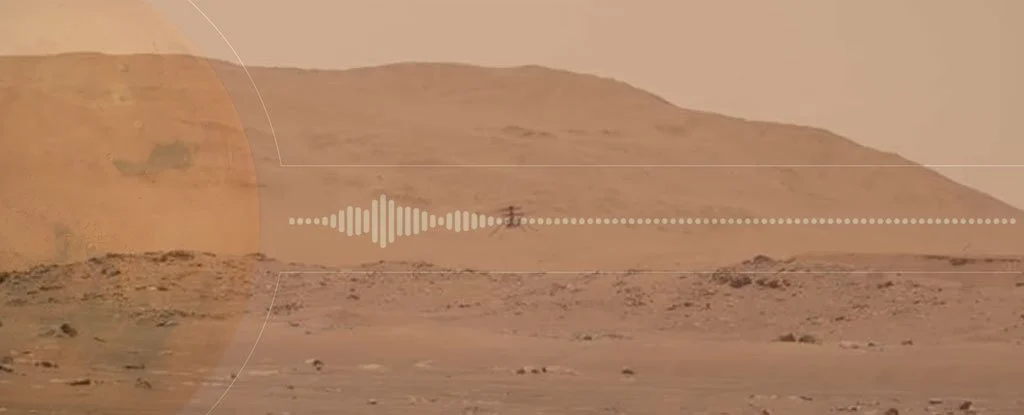Have a Listen to The NASA’s Perseverance Captures Video, Audio of Fourth Ingenuity Flight
PostedAt: Sat, May 8, 2021 8:28 AM
Sounds of the Mars Helicopter’s whirring rotors add another new dimension to the historic project.Sounds of the Mars Helicopter’s whirring rotors add another new dimension to the historic project
NASA's Perseverance rover has for the first time captured the low-pitched whirring of the Ingenuity helicopter's blades as it flies through the rarefied Martian atmosphere.
The space agency on Friday released new footage shot by the six-wheeled robot of its rotorcraft companion making its fourth flight on April 30 – this time accompanied by an audio track.
The nearly three-minute-long video begins with the low rumble of the wind blowing across the Jezero Crater, where Perseverance landed in February on a mission to search for signs of ancient microbial life.
Ingenuity takes off, and its blades can be heard humming softly as they spin at nearly 2,400 rpm on the 872-foot (262-meter) roundtrip.
The mission's engineers weren't sure they would pick up the flight sound at all, given that Perseverance was parked 262 feet (80 meters) aware from the takeoff and landing spot.
The Martian atmosphere is about one percent the density of our planet's, making everything much quieter than on Earth.
"This is a very good surprise," said David Mimoun, a professor of planetary science at Institut Superieur de l'Aeronautique et de l'Espace (ISAE-SUPAERO) in Toulouse, France, and science lead for the SuperCam Mars microphone.
"We had carried out tests and simulations that told us the microphone would barely pick up the sounds of the helicopter, as the Mars atmosphere damps the sound propagation strongly," he added.
The SuperCam is an instrument on board Perseverance that laser-zaps rocks from a distance, in order to study their vapor with a device called a spectrometer that reveals their chemical composition.
It also comes with a microphone to record the sounds, which yields additional insights into the physical properties of the targets, like how hard they are.
Similarly, explained Mimoun, the new recording of Ingenuity's flight "will be a gold mine for our understanding of the Martian atmosphere."
Apart from having a lower volume, sounds emitted on Mars travel slower than they do on Earth, because of cold temperatures, which average minus 81 degrees Fahrenheit (minus 63 degrees Celsius) on the surface.
The speed of sound on the planet is therefore around 540 mph (roughly 240 meters per second), compared to about 760 mph (roughly 340 meters per second) here.
The atmosphere of Mars, made up of 96 percent carbon dioxide, tends to absorb higher-pitched sounds, so only lower-pitched sounds can travel long distances.
Audio enhanced
NASA enhanced the audio, which was recorded in mono, by isolating the pitch of the helicopter blades at 84 hertz, and reducing audio at frequencies below 80 and above 90 hertz. They then increased the volume of the remaining signal.
Soren Madsen, Perseverance payload development manager at NASA's Jet Propulsion Laboratory, said the recording was an example of how the mission's instruments are able to work in tandem to enhance our understanding of the Red Planet.
For the first time, a spacecraft on another planet has recorded the sounds of a separate spacecraft. NASA’s Perseverance Mars rover used its SuperCam microphone to listen to the Ingenuity helicopter on April 30, 2021, as it flew on Mars for the fourth time.
Credit: NASA/JPL-Caltech/LANL/CNES/CNRS/ISAE-Supaéro
“This is a very good surprise,” said David Mimoun, a professor of planetary science at Institut Supérieur de l’Aéronautique et de l’Espace (ISAE-SUPAERO) in Toulouse, France, and science lead for the SuperCam Mars microphone. “We had carried out tests and simulations that told us the microphone would barely pick up the sounds of the helicopter, as the Mars atmosphere damps the sound propagation strongly. We have been lucky to register the helicopter at such a distance. This recording will be a gold mine for our understanding of the Martian atmosphere.”
Scientists made the audio, which is recorded in mono, easier to hear by isolating the 84 hertz helicopter blade sound, reducing the frequencies below 80 hertz and above 90 hertz, and increasing the volume of the remaining signal. Some frequencies were clipped to bring out the helicopter’s hum, which is loudest when the helicopter passes through the field of view of the camera.
As Ingenuity moves away from Perseverance and out of shot, the pitch decreases, and as it returns, the pitch increases.
This is known as the Doppler Effect, and it provides an additional layer of confirmation of the helicopter's flight path when it is out of visual range.
Ingenuity first flew on April 19, the first powered, controlled flight on another planet, and was set to carry out its fifth on Friday at 3:26 pm Eastern Time (1926 GMT), with data coming down no sooner than four hours later.
After proving itself more robust than its engineers had imagined, the 4-pound (1.8-kilogram) mini chopper will then embark on a new mission, to scout ahead of the Perseverance rover to assist in its hunt for ancient life.
Article Source
and If you wish to take away this text from our web site please Email us











